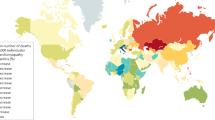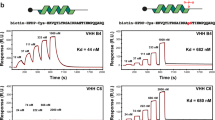Abstract
We recently reported that mice deficient in the programmed cell death-1 (PD-1) immunoinhibitory coreceptor develop autoimmune dilated cardiomyopathy (DCM), with production of high-titer autoantibodies against a heart-specific, 30-kDa protein. In this study, we purified the 30-kDa protein from heart extract and identified it as cardiac troponin I (cTnI), encoded by a gene in which mutations can cause familial hypertrophic cardiomyopathy (HCM). Administration of monoclonal antibodies to cTnI induced dilatation and dysfunction of hearts in wild-type mice. Monoclonal antibodies to cTnI stained the surface of cardiomyocytes and augmented the voltage-dependent L-type Ca2+ current of normal cardiomyocytes. These findings suggest that antibodies to cTnI induce heart dysfunction and dilatation by chronic stimulation of Ca2+ influx in cardiomyocytes.
This is a preview of subscription content, access via your institution
Access options
Subscribe to this journal
Receive 12 print issues and online access
$209.00 per year
only $17.42 per issue
Buy this article
- Purchase on Springer Link
- Instant access to full article PDF
Prices may be subject to local taxes which are calculated during checkout




Similar content being viewed by others
References
Richardson, P. et al. Report of the 1995 World Health Organization/International Society and Federation of Cardiology Task Force on the definition and classification of cardiomyopathies. Circulation 93, 841–842 (1996).
Cohn, J.N. et al. Report of the National Heart, Lung, and Blood Institute Special Emphasis Panel on heart failure research. Circulation 95, 766–770 (1997).
Matsumori, A. et al. Epidemiologic and clinical characteristics of cardiomyopathies in Japan. Circ. J. 66, 323–236 (2002).
Herskowitz, A., Neumann, D.A. & Ansari, A.A. Concepts of autoimmunity applied to idiopathic dilated cardiomyopathy. J. Am. Coll. Cardiol. 22, 1385–1388 (1993).
Pankuweit, S. et al. Autoantibodies in sera of patients with myocarditis: characterization of the corresponding proteins by isoelectric focusing and N-terminal sequence analysis. J. Mol. Cell. Cardiol. 29, 77–84 (1997).
Schultheiss, H.P. et al. The ADP/ATP carrier as a mitochondrial auto-antigen—facts and perspectives. Ann. NY Acad. Sci. 488, 44–64 (1986).
Maisch, B. et al. Diagnostic relevance of humoral and cytotoxic immune reactions in primary and secondary dilated cardiomyopathy. Am. J. Cardiol. 52, 1072–1078 (1983).
Neumann, D.A. et al. Circulating heart-reactive antibodies in patients with myocarditis or cardiomyopathy. J. Am. Coll. Cardiol. 16, 839–846 (1990).
Staudt, A. et al. Immunohistological changes in dilated cardiomyopathy induced by immunoadsorption therapy and subsequent immunoglobulin substitution. Circulation 103, 2681–2686 (2001).
Matsumori, A. & Kawai, C. An experimental model for congestive heart failure after encephalomyocarditis virus myocarditis in mice. Circulation 65, 1230–1235 (1982).
Alvarez, F.L. et al. Heart-specific autoantibodies induced by coxsackievirus B3: identification of heart autoantigens. Clin. Immunol. Immunopathol. 43, 129–139 (1987).
Matsui, S. et al. Peptides derived from cardiovascular G-protein-coupled receptors induce morphological cardiomyopathic changes in immunized rabbits. J. Mol. Cell. Cardiol. 29, 641–655 (1997).
Neu, N. et al. Cardiac myosin induces myocarditis in genetically predisposed mice. J. Immunol. 139, 3630–3636 (1987).
Neu, N., Ploier, B. & Ofner, C. Cardiac myosin-induced myocarditis. Heart autoantibodies are not involved in the induction of the disease. J. Immunol. 145, 4094–4100 (1990).
Okazaki, T., Iwai Y., & Honjo, T. New regulatory co-receptors: inducible co-stimulator and PD-1. Curr. Opin. Immunol. 14, 779–782 (2002).
Nishimura, H. et al. Autoimmune dilated cardiomyopathy in PD-1 receptor-deficient mice. Science 291, 319–322 (2001).
Seidman, J.G. & Seidman, C. Cell 104, 557–567 (2001).
Kimura, A. et al. Mutations in the cardiac troponin I gene associated with hypertrophic cardiomyopathy. Nat. Genet. 16, 379–382 (1997).
Solaro, R.J. Troponin I, stunning, hypertrophy, and failure of the heart. Circ. Res. 84, 122–124 (1999).
Towbin, J.A. The role of cytoskeletal proteins in cardiomyopathies. Curr. Opin. Cell. Biol. 10, 131–139 (1998).
Kamisago, M. et al. Mutations in sarcomere protein genes as a cause of dilated cardiomyopathy. N. Engl. J. Med. 343, 1688–1696 (2000).
Solaro, R.J. & Rarick, H.M. Troponin and tropomyosin: proteins that switch on and tune in the activity of cardiac myofilaments. Circ. Res. 83, 471–480 (1998).
Shou, W. et al. Cardiac defects and altered ryanodine receptor function in mice lacking FKBP12. Nature 391, 489–492 (1998).
Molkentin, J.D. et al. A calcineurin-dependent transcriptional pathway for cardiac hypertrophy. Cell 93, 215–228 (1998).
Knollmann, B.C. et al. Remodelling of ionic currents in hypertrophied and failing hearts of transgenic mice overexpressing calsequestrin. J. Physiol. 525, 483–498 (2000).
Schultheiss, H.P. et al. Antibody-mediated enhancement of calcium permeability in cardiac myocytes. J. Exp. Med. 168, 2105–2119 (1988).
Staudt, A. et al. β1-adrenoceptor antibodies induce positive inotropic response in isolated cardiomyocytes. Eur. J. Pharmacol. 423, 115–119 (2001).
Felix, S.B. et al. Removal of cardiodepressant antibodies in dilated cardiomyopathy by immunoadsorption. J. Am. Coll. Cardiol. 39, 646–652 (2002).
Murphy, A.M. et al. Transgenic mouse model of stunned myocardium. Science 287, 488–491 (2000).
Keffer, J.H. Myocardial markers of injury. Evolution and insights. Am. J. Clin. Pathol. 105, 305–320 (1996).
Schulze, K. et al. Disturbance of myocardial energy metabolism in experimental virus myocarditis by antibodies against the adenine nucleotide translocator. Cardiovasc. Res. 44, 91–100 (1999).
Kobuke, K. et al. ESDN, a novel neuropilin-like membrane protein cloned from vascular cells with the longest secretory signal sequence among eukaryotes, is up-regulated after vascular injury. J. Biol. Chem. 276, 34105–34114 (2001).
Mizoguchi, A. et al. Localization of rabphilin-3A on the synaptic vesicle. Biochem. Biophys. Res. Commun. 202, 1235–1243 (1994).
Nishio, R. et al. Left ventricular pressure-volume relationship in a murine model of congestive heart failure due to acute viral myocarditis. J. Am. Coll. Cardiol. 40, 1506–1514 (2002).
Takagi, S., Kihara, Y., Sasayama, S. & Mitsuiye, T. Slow inactivation of cardiac L-type Ca2+ channel induced by cold acclimation of guinea pig. Am. J. Physiol. 274, R348–R356 (1998).
Isenberg, G. & Klockner, U. Calcium tolerant ventricular myocytes prepared by preincubation in a “KB medium”. Pflugers. Arch. 395, 6–18 (1982).
Powell, T. et al. Electrical properties of individual cells isolated from adult rat ventricular myocardium. J. Physiol. 302, 131–153 (1980).
Hamill, O.P. et al. Improved patch-clamp techniques for high-resolution current recording from cells and cell-free membrane patches. Pflugers. Arch. 391, 85–100 (1981).
Acknowledgements
We thank A. Noma, K. Yamauchi-Takihara, K. Kobuke, T. Nakamura, I. Okazaki and members of the Honjo laboratory for helpful discussions; S. Shibayama, Y. Odagaki and M. Matsuo (Ono Pharmaceutical) and APRO Life Science Institute for assistance with antigen determination; and E. Inoue for technical assistance. This work was supported by a Center of Excellence Grant from the Ministry of Education, Science, Sports, Culture and Technology of Japan. J.W. is a research fellow of the Japan Society for the Promotion of Science.
Author information
Authors and Affiliations
Corresponding author
Ethics declarations
Competing interests
The authors declare no competing financial interests.
Supplementary information
Rights and permissions
About this article
Cite this article
Okazaki, T., Tanaka, Y., Nishio, R. et al. Autoantibodies against cardiac troponin I are responsible for dilated cardiomyopathy in PD-1-deficient mice. Nat Med 9, 1477–1483 (2003). https://doi.org/10.1038/nm955
Received:
Accepted:
Published:
Issue Date:
DOI: https://doi.org/10.1038/nm955
This article is cited by
-
Immune checkpoints in cardiac physiology and pathology: therapeutic targets for heart failure
Nature Reviews Cardiology (2024)
-
The PD-1–PD-L1 pathway maintains an immunosuppressive environment essential for neonatal heart regeneration
Nature Cardiovascular Research (2024)
-
A comprehensive review on immune checkpoint inhibitors induced cardiotoxicity characteristics and associated factors
European Journal of Medical Research (2023)
-
Fasting mimicking diet in mice delays cancer growth and reduces immunotherapy-associated cardiovascular and systemic side effects
Nature Communications (2023)
-
Insights from a 30-year journey: function, regulation and therapeutic modulation of PD1
Nature Reviews Immunology (2023)



